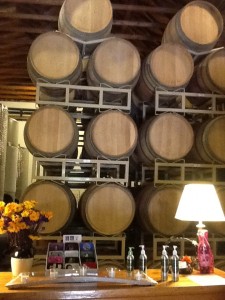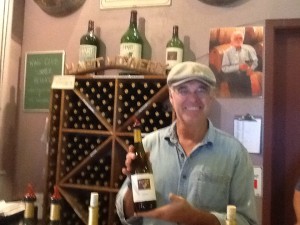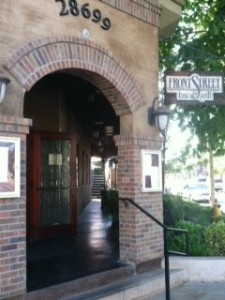Archive for the ‘review red blend’ Category
Putting the Heart Back in Winemaking: Hart Family Winery
Hart Family Winery Is a long way from Napa. Really.
It’s in Temecula, about 500 miles away in the rolling hills of sunny Southern California. This pretty little town has a little bit of everything, from palm trees to cowboy bars. What it doesn’t have is Napa’s slick, corporate feel.
Hart Family Winery reminds me of Napa 20 years ago, when tasting rooms were just set-ups in a working winery, the owner/winemaker was leaning on a barrel chatting with guests, and the passion of everyone in the room was abundantly evident.
When we walked through the door at Hart Family, the party was in full swing. Not only was founder Joe Hart chatting away by the tasting bar, but assistant winemaker Daniel Denison was pouring behind it. Dennis filled us in on the unique features of the Temecula AVA.
Like its northern counterparts, the Temecula AVA sits less than a mile from the cool Pacific Ocean. But down here south of Los Angeles, there is no cooling fog layer like up in Sonoma County, or brisk afternoon breezes like in Paso Robles. The temperatures here climb to 90 or so during the day, but don’t drop much below 70 at night. That’s not much of a diurnal temperature shift, and that temperature shift is one of the key factors in creating structure in wine grapes.
Here’s how Dennis put it: “Our main challenge here is to maintain acid levels and control sugar levels. We don’t want overly “jammy ” wines.” Careful canopy management (pruning or shaping the leaves on the vines that shade and protect the grapes) helps mitigate summer heat. Irrigation is also necessary in the dry climate.
So what about those wines? We were very pleasantly surprised by a wonderfully snappy Sauvignon Blanc (Hart Family Temecula Valley 2012) that showed just a hint of grapefruit along with a nice core of juicy apricot. It apparently sees a bit of oak, but it’s not obvious except in the slightly rounded mouth-feel. I thought the winemaker did a great job of balancing fruit and acid.
We made our way through a series of red Rhone varietals, which along with Mediterranean varietals have become the favored grape varieties for Temecula’s Mediterranean climate. My favorite was the 2010 Hart Family Vineyard Syrah, which offered soft berry flavors and an almost Pinot-like mouthfeel. It was fruity (but not jammy), and the velvety finish showed just a hint of white pepper to keep it lively.
For a visit to more traditional California flavors, we tried the 2011 Temecula Valley Huis Vineyard Zinfandel. Wow – what a departure from the typical prune-y, overly-alcoholic Lodi Zin. Daniel said they actually bring their Zinfandel grapes in early, when alcohol levels are lower, to maintain a more elegant balance in the wine. I loved the delicate blueberry and raspberry notes that offer flavor without weight, and the amazingly restrained 13.2% ABV. When was the last time you saw that in a California Zin??
Another favorite was the 2009 Hart Family Driveway Red (made from grapes grown adjacent to the winery’s driveway!). This is a true field blend, made in the traditional style with three varietals co-fermented and aged together in barrel. I think this method produces something like “sibling harmony” – you know, where three sibling voices blended together will make the best musical harmonies. This blend of Merlot, Cabernet Sauvignon and Cabernet Franc has plenty of richness and body, with cassis, blackberry and a bit of chocolate all dancing on the tongue. This is one of the bottles that went home with us.
Thanks to Joe Hart, who helped pioneer grape growing in Southern California and leads the way for Temecula today with top-quality wines. We’re looking forward to visiting the area again.
Teeth-Staining Intensity from Purple Wine Company
Your wine can be purple in your glass.
Your hands can be purple after pouring bottle after bottle.
Your teeth can be purple after sipping too much Petite Sirah.
Or your Wine Company can be Purple.
Derek Benham founded Purple Wine Company in 2001, after selling a value-oriented brand called Blackstone that he had co-founded. I’m sure you remember Blackstone: it produces a wine that has been, at times, America’s best-selling Merlot.
So the guy knows how to make wine, and how to make money with wine.
Enter Four Vines. This wine company was founded in 1994 by three folks who wanted to focus on making Zinfandel: big, bold, kick-ass Zins from the best Zin regions in California. Christian Tietje built the Four Vines brand with two under-$15 labels and three region-specific Zins. All were highly-rated and regarded as good values.
And now Four Vines is part of Purple Wine Company, purchased by Derek Benham about two years ago. I recently had the opportunity to taste those three appellation Zins, as well as a new PWC wine called Cryptic.
I started with Four Vines “Biker” Zinfandel Paso Robles 2009, because Paso Zins have always gotten my vote for the Best in Varietal. This one is made with fruit from two vineyards in West Side Paso Robles, including one of my all-time faves, Dante Dusi vineyard. West Side Paso is heaven for warm-climate grapes, with hot, sunny days and very cool nights that produce intense flavors and good structure. Calcareous soils (that means chalky/limestone-y) also keep yields low and flavors concentrated. Read the rest of this entry »
Chamisal Vineyards: Kiwis Invade California!!
Well, not really. There’s just one Kiwi that I know of, but I think he’s made a big impression…
Fintan du Fresne is the New Zealand-born winemaker for Chamisal Vineyards in California’s amazingly beautiful Edna Valley. These rolling hills are situated about halfway between San Francisco and Los Angeles, but are a world apart from both. I know — I’ve been there. And I still remember the spectacular view from Jean Pierre Wolfe’s front porch, as vineyards and rolling hills framed a glimpse of the Pacific Ocean in the distance.
Only it’s not very distant: Chamisal’s vineyards are just five miles from the Pacific, and Edna Valley is the California AVA that’s closest to the ocean.
Fintan says the ocean defines Chamisal’s wines. If you look at the videos on their very cool website, you can see the marine layer (or fog bank) that rolls in from the ocean and covers the valley’s vineyards most summer mornings. The fog cools down the vines, acting like a giant wet blanket that slows the development of the grapes. Is this a bad thing? Not at all. Cool is actually good, because the longer the grapes hang on the vine, the more complex and intense the flavors become. The result is wines that are delicate but intense — an award-winning combination.
Chamisal also holds a special distinction in this AVA: its vineyards were the first planted in the Edna Valley back in 1973. Chamisal now grows five varietals, and we tasted most of them during a recent streaming live online wine tasting. It was delightful to hear Fintan du Fresne (and his sexy Kiwi accent) talk about Chamisal Vineyards and its wines, the first of which was a stunning example of Fintan’s influence.
Chamisal Stainless Steel Chardonnay Central Coast 2011 is what happens when a New Zealand palate meets California fruit. New Zealand’s very cool climate produces wines high in acid and bursting with lime and grapefruit flavors (drinking some NZ Sauv Blanc is like sucking on a grapefruit…). It’s as far away as you can get from the traditional California style that favors (or at least, used to favor) lots of oak and butter.
When Fintan came to Chamisal, the first thing he did was create a bright, clean, snappy white wine. This is the “no” Chardonnay: no oak barrel aging, no malolactic fermentation, no sur lie aging. He uses a long, cool fermentation to deliver fresh, bright fruit flavors with lots of natural acidity.
But I found this wine surprisingly rich. The nose offered lots of floral aromas and candied fruit, and the palate led with rich tropical flavors. Exotic floral notes crept in behind, followed by a spice note that’s quite unique. Fintan calls this “Chamisal spice,” and says it’s a terroir thing that manifests in all Chamisal wines. I enjoyed this wine, and think it will make a great summer quaffer for all those who want flavor without oak. It’s worth noting, too, that this Chard is from the much-vilified 2011 growing season, which threw vintners and winemakers all sorts of nasty weather curves. Fintan said he actually liked this vintage because it created fruit that was better suited to the stainless style. Read the rest of this entry »
“America, I’d like you to meet Acid…” Double Decker Wines
 OK, so I tasted several wines recently that seemed to depart pretty significantly from what I’ve come to expect from American wines in the $10 price range.
OK, so I tasted several wines recently that seemed to depart pretty significantly from what I’ve come to expect from American wines in the $10 price range.
Were these wines jammy? No
Were they tooty-fruity (that’s a technical term…)? No
Were they big, fat cocktail wines? Again, no.
Both whites and reds showed great balance, with plenty of acid on the back to balance the fruit on the front end.
This shouldn’t be a big deal, right? But it is. It seems like the $10-and-under domestic market has been taken over by slightly-sweet Pinot Grigios; fleshy, raisin-y Zins; and red blends with enough residual sugar to make my teeth ache.
So, YES, I was thrilled when I tasted through the portfolio of Double Decker Wines, a “new” brand made by the folks at Wente Vineyards. The brand is aimed squarely at the Generation Whatever crowd — younger drinkers coming into the wine market, who want wines that are fun and unpretentious. (But trust me, they’ll also sell well to those of us over-40′s who drink wine with dinner every night and don’t want to plunk down a twenty for each bottle).
The Double Decker winemaking team is young enough to connect well with its audience. Thirty-something winemaker Karl Wente is the fifth generation of his family to be riding the vineyards on their Livermore, California property. The flagship winery dates back to 1883, and has been a leader in California winemaking all along (ever heard of Wente Clone Chardonnay?)
For the Double Decker project, they source fruit other vineyards, with some pretty impressive results. Let’s get to it.
Double Decker Pinot Grigio 2010 makes me think of Europe, not California. Made with fruit sourced from cool-climate Arroyo Seco, it shows its stuff right off the bat with a nose of delicate pear and pretty florals. The palate led with some tropical notes, but quickly showed some spice and snap. What lingered on my palate was tangy acidity — a clean, refreshing finish.
I (and several other bloggers) talked to Karl about the wine through a streaming online event (which is also very cool, by the way). He shared some of his winemaking secrets: one of those is that he blends a few percentage points of Riesling and Viognier into his Pinot Grigio. Karl says that these floral, aromatic grapes don’t really announce their presence, but just accentuate the fruit character of the Pinot Grigio.
He goes even further in his pursuit of balance: like the European winemakers, he picks his grapes at a lower brix (that means, when the sugar levels are lower) so that the wine will retain that bright natural acidity.
Yup, it all worked very well for me.
The Best of the Pacific Northwest: Sineann Abondante 2009

Peter Rosback of Sineann Winery
How does this guy do it?
How does he produce so many great wines in such a dizzying variety of styles. How can one guy be responsible for all these:
A) Incredibly rich Old Vine Zinfandel;
B) Crisp and snappy New Zealand Sauv Blanc;
C) Bold but elegant single vineyard Willamette Valley Pinot Noirs; and
D) Intense but polished Washington State red blends.
And did I mention this guy has earned several boatloads of 90+ scores for all these disparate styles??
His name is Peter Rosback, master of Sineann Winery. He’s physically located in the Chehalem Mountains AVA near Newberg, Oregon, but his grapes come from all over the place. He’s one of the new breed of winemakers who doesn’t rely on owning acres of vineyards to produce estate-grown wines, but sources grapes from the best vineyards he can lay his hands on. Peter uses fruit from vineyards in Oregon, the Columbia Valley, and even Marlborough, New Zealand. (Yes, he flies halfway around the world to make his Sauv Blanc!)
It’s a smart approach these days, when you have to be a retired football star or race car driver to be able to pony up the multi-$100,000 per acre it takes to plant your own vineyards, and then pay vineyard workers and winemaking staff for seven or so years before you can actually sell any wine. Instead of owning land, Peter locates pedigreed vineyards and then “works closely with” (read, “drives crazy”) his growers to produce the best fruit possible. It’s a way of doing business that allows Peter tremendous flexibility as a winemaker, while still maintaining control over his product.
But if you could say there’s a signature style to all of Peter’s wines, it would probably be intensity of fruit and concentration of flavors. Aha! That’s one of the things Peter creates in the vineyards. He works with his growers to reduce crop yields way below most premium or super-premium wines: he goes as low as one ton per acre. Trust me, that’s LOW! (A premium Napa Valley grape grower might harvest two and a half to three tons per acre).
 So why does he do it? The short answer is that reducing the number of grapes each vine produces greatly increases the concentration and intensity of flavor in every single grape. And believe me, it shows in Peter’s wine.
So why does he do it? The short answer is that reducing the number of grapes each vine produces greatly increases the concentration and intensity of flavor in every single grape. And believe me, it shows in Peter’s wine.
So let’s get to the wine. I recently went nuts over the Sineann Abondante 2009, a red blend made with fruit from vineyards in the lower Columbia Valley. Now I have to admit that I ordered this wine without ever tasting or even reading about it: I just figured that I’d love anything from the winemaker who’d made the amazing Sineann Resonance Vineyard Pinot Noir (with scores in every vintage hovering near the mid-90′s).
So I poured Abondante at a wine and food pairing dinner, where I’d made an admittedly wild-ass guess about how the wine would taste and pair with my food. Truthfully, I just wanted to drink it. The wine is an intriguing blend of grapes grown in the Columbia Valley. There is Merlot from the Hillside Vineyard, Cabernet Franc from the famed Champoux Vineyard, Cabernet Sauvignon from the Hillside Vineyard and Zinfandel (yes, Washington State Zinfandel) from vineyards that are reputed to be the oldest in the Pacific Northwest.
Wild, huh?
And it does honor to its name. “Abondante” means “generous,” and those abundant flavors jump right out of the glass. There’s rich berry fruit, which may be contributed by the old vine Zinfandel. There are floral and herbal notes (maybe from the Cab Franc?) as well as some plum and pomegranate. All of this is wrapped up in soft tannins and a round ripeness, but not jamminess, that smooths out the finish.
That’s what I liked best: intensity without weight. The fruitiness and structure all danced happily together, creating a very lithe and refined wine that just happened to be rich in fruit flavors.
This wine was kick-ass. And the good news is that it worked perfectly with Beef Filet Medallions topped with Gorgonzola and a Red Wine Reduction. Who would have thought? Like I said, I just wanted to taste the wine…
Try hard to find a bottle of 2009 Abondante, although it’ll be tough given Sineann’s small production and the ridiculously low price for this wine ($30 in my state). But do your best, because you’ll go nuts like I did… Cheers!


